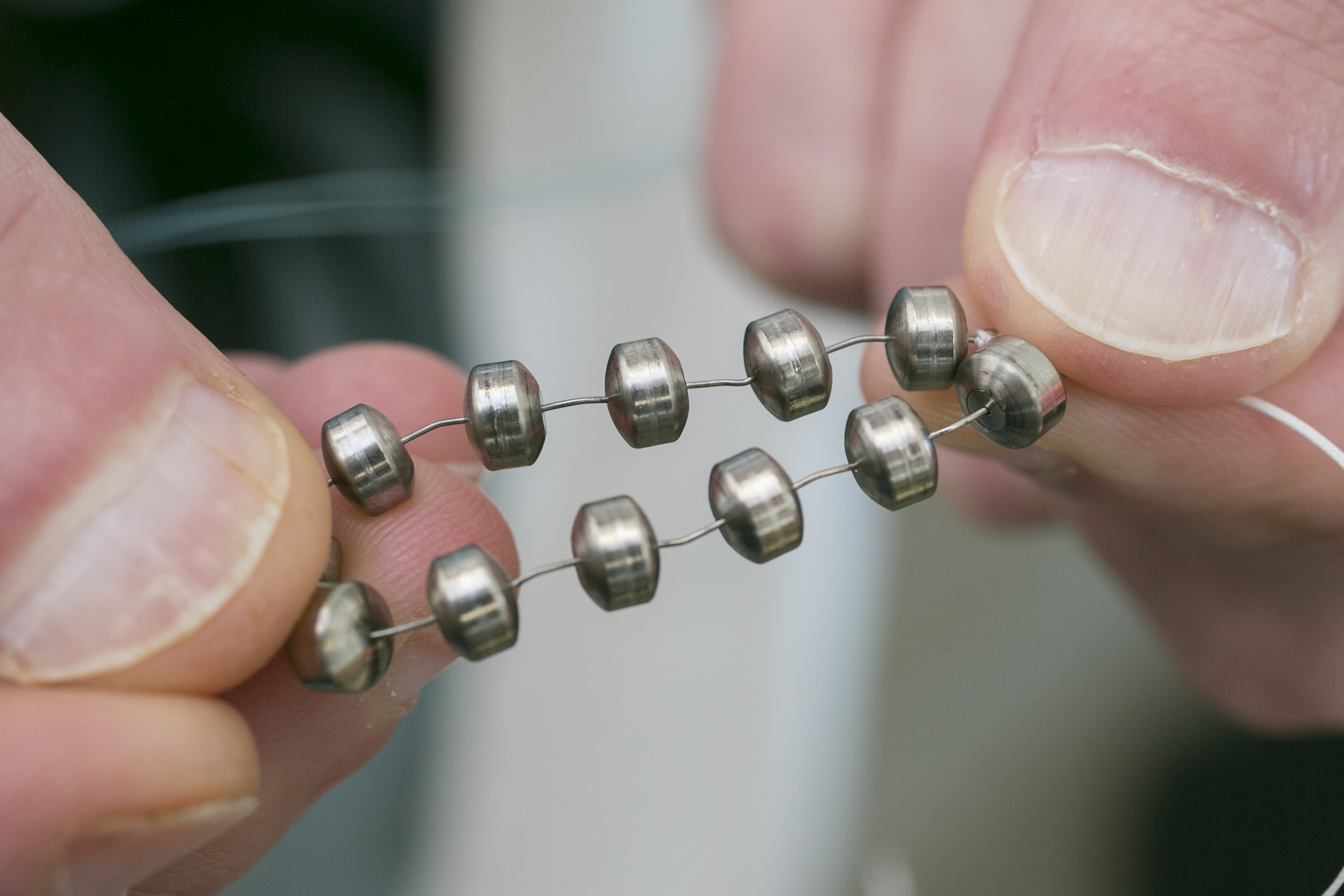 Surgeon Dr. John Lipham demonstrates an opened Linx device at the Hoag Memorial Hospital Presbyterian in Newport Beach, Calif. on Thursday. The small band of magnetic beads is used to treat chronic heartburn. The bracelet-like device is implanted around a weak muscle at the base of the throat that doesn't close as it should and helps prevent stomach acid from splashing back into the throat.
Surgeon Dr. John Lipham demonstrates an opened Linx device at the Hoag Memorial Hospital Presbyterian in Newport Beach, Calif. on Thursday. The small band of magnetic beads is used to treat chronic heartburn. The bracelet-like device is implanted around a weak muscle at the base of the throat that doesn't close as it should and helps prevent stomach acid from splashing back into the throat.A tiny magnetic bracelet implanted at the base of the throat is greatly improving life for some people with chronic heartburn who need more help than medicine can give them.
It's a novel way to treat severe acid reflux, which plagues millions of Americans and can raise their risk for more serious health problems.
It happens when a weak muscle doesn't close after swallowing as it should. That lets stomach juices splash back into the throat. Drugs like Nexium and Prilosec reduce acid. But they don't fix the underlying problem, called GERD, or gastroesophageal reflux disease.
Rodd Foster had it so bad he used to sleep sitting up to keep his dinner down. Tricia Carr worried she would develop complications like the one that killed her mother.
Both Californians got help from the new device, approved a year ago by the federal Food and Drug Administration and also sold in Europe.
The treatment was "life-changing," said Foster, a 61-year-old plumbing contractor from Canyon Country, Calif. "It's been 30 years since I've been able to eat normally and now I can eat anything anytime."
The Linx device, made by Torax Medical Inc., of St. Paul, Minn., is a ring of titanium beads with magnets inside. Doctors place it around the weak muscle at the base of the esophagus in a half-hour operation using a scope and "keyhole" incisions in the belly. The ring reinforces the weak muscle to keep it closed, yet is flexible and expands to let food pass when someone swallows. The ring comes in multiple sizes; it is about a half-inch in diameter and expands to about 1.5 inches. People don't feel it once it is implanted.
The device costs $5,000; the operation can run $12,000 to $20,000 depending on hospital charges, said Dr. John Lipham, a surgeon who offers it at the University of Southern California and at Hoag Memorial Hospital Presbyterian in Newport Beach. Many insurers cover it for patients who are not helped enough by antacid medicines.
"It is a clever device," said another doctor who has used it - Dr. Donald Castell, a gastroenterologist at the Medical University of South Carolina in Charleston. The magnets "just bolster a little bit the pressure that is normally there" and help seal off the stomach juices, he said.
Both doctors consult for Torax. A third expert with no financial ties to the company - Dr. Daniel DeMarco of Baylor University Medical Center in Dallas - said early results with the device have been "very impressive." But only time will tell if they hold up for many years, he said.
As many as 20 million Americans have GERD. It's not just a quality-of-life issue: Chronic acid reflux can raise the risk of a condition called Barrett's esophagus, which in turn can raise the risk of throat cancer.
"No one doubts that reflux should be treated," but most people get enough relief from acid-lowering medicines, said Dr. Brian Reid. He's director of the Barrett's esophagus program at Fred Hutchinson Cancer Research Center in Seattle.
Antacids didn't work for Carr, a 54-year-old nurse.
"You're having a wonderful time and all of a sudden it hurts. It's horrible," she said. Her mother had a serious complication from chronic reflux - lung scarring that led to her death. "So I really was anxious about having my GERD fixed," Carr said.
Lipham gave a presentation on the device at a staff training session at Hoag, the Newport Beach hospital where Carr works.
"After his talk I went right over to him and said, 'I need one of those things,"' she said. The device, which she received in October at the USC hospital in Los Angeles, "completely fixed it immediately," she said of her reflux.
A side benefit: She eats more slowly and chews her food more to avoid swallowing problems that some people have right after surgery. And she said that has helped her drop 10 pounds.
Lipham and other doctors recently published a study of the device in 100 patients in the New England Journal of Medicine. All had had reflux for at least 10 years and were getting worse despite using antacids.
After having the magnetic ring implanted, acid measured in their throats greatly decreased. Quality of life improved substantially for 92 percent, and within one year, 86 percent no longer needed acid-lowering medicines.
The most frequent side effect was difficulty swallowing, which occurred in 68 percent of patients right after surgery. That dropped to 11 percent after one year and 4 percent after three years.
Six of the 100 had to have the device removed. In three it was because swallowing problems persisted. Other problems prompted removal in the others.
